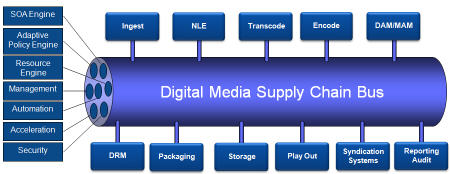-
Signiant: Plumber for Broadband Video Era
As many of you know, business development executives (and CEOs!) tend to be guilty of "throwing completed deals over the wall", expecting operations people and developers to implement as intended, while they move on to do the next deal. I know this first-hand as I was a biz dev guy for many years!
Yet, as I learned over many years and with multiple companies, each and every deal comes with its own particular implementation characteristics. These include things like multiple formats, encoding rates, business rules, file transfer processes, approvals and so forth. Do enough deals and pretty soon you've introduced massive complexity into your organization involving tons of manual tasks and costs which can quickly erase any profitability the underlying deal assumed.
This is where a company named Signiant comes into play. They're a sort of "plumber for the broadband video era." This unglamorous-sounding description does them no injustice; just think for a moment what the world would be like without actual plumbing, and you then you'll begin to appreciate how important the role
 is that Signiant plays in powering broadband video. The executive team includes a number of ex-Avid people, who bring a valuable perspective to the challenges of broadband video distribution. And as the broadband video market matures further and a spiraling number of deals get done, the plumbing to move all this video around only becomes more complex.
is that Signiant plays in powering broadband video. The executive team includes a number of ex-Avid people, who bring a valuable perspective to the challenges of broadband video distribution. And as the broadband video market matures further and a spiraling number of deals get done, the plumbing to move all this video around only becomes more complex. Last week I caught up with Tony Lapolito, Signiant's VP of Marketing who shared the company's strategy and product details. While the company's been around for over 10 years (staring as an internal project at Nortel), it has only identified the media industry as a key vertical focus in the last 2 years. It has quickly won respect, working with marquee customers like NBC, Disney, BT and just yesterday announcing a deal with Current.
Signiant brings an enterprise orientation to broadband video delivery, considering itself a "digital media supply chain" company. This may be unfamiliar territory for some of you, so to boil it down, the point of Signiant is to ensure that desired content is where it needs to be, when it needs to be there, and delivered with maximum efficiency, least cost and highest security/reliability. Below is a basic diagram depicting how Signiant works.

Signiant allows users to set up work flow processes to automatically handle a wide range of tasks. For example, NBC currently uses Signiant to securely distribute its content to approximately 20 partners following business rules for each. Tony said NBC expects its partnership roster to rise to 200 in the next 2 years and that Signiant will allow it to scale by allowing easy configuration of the content distribution process and business rules for each of these new deals.
Signiant does a lot of other things, such as prioritizing and allocating bandwidth, tracking all digital assets and managing approvals, all while tying into existing digital asset management systems and other legacy platforms in use. For Current, Signiant is streamlining the process of uploading viewer-created content, allowing Current to more quickly collect, approve and post inbound video.
There's not enough space to get into further detail, but suffice to say, if your operation is already groaning under the weight of implementing myriad deals, and/or you're pursuing a distribution-centric business strategy for your broadband video assets, it's well worth understanding the technology and business case behind Signiant.
Categories: Technology
Topics: Signiant

